Fresh, Hardened, and Microstructural Properties of Ambient Cured One-Part Alkali-Activated Self-Consolidating Concrete
Abstract
:1. Introduction
2. Experimental Characterization
2.1. Materials Characterization
2.2. Mixtures Designations
2.3. Testing Properties
3. Results and Discussion
3.1. Fresh Properties
3.1.1. Filing Ability
3.1.2. Passing Ability
3.1.3. Segregation Resistance (SR)
3.1.4. Effects of Selected Activator and Dosage
3.1.5. Effect of Precursor Combination
3.2. Hardened Properties
3.2.1. Compressive Strength Development
3.2.2. Electrical Bulk Resistivity
3.2.3. Ultrasonic Pulse Velocity (UPV)
3.2.4. Capillary Sorptivity
3.2.5. Permeable Pores Test
3.3. Microstructural Analysis
4. Concluding Remarks
- The proper selection of precursor materials, proportions, activator type, and dosage plays a decisive role in the effective development of AASCC mixtures in the absence of a distinct methodology.
- The higher fraction of sodium carbonate/silicate activators in all systems, single, binary, and ternary, contributed to the delayed reaction kinetics due to their nature. The combination of 20% to 25% activator dosage is recommended to achieve satisfactory fresh and mechanical properties.
- Slag substitution with various SF or FA class-F ratios can correct the particle size distribution of the total binder material and improve the fresh concrete characteristics in binary and ternary systems.
- For all AASCC mixtures, a 25% activator dosage resulted in the highest UCS and UPV values, particularly in binary-SF and ternary-1 mixtures of more than 50 MPa after 90 days than other combinations.
- The formation of different reaction products and binding gels, i.e., C-(N)-A-S-H, strongly influences the different transport mechanisms, such as capillary sorptivity, permeable pores, and bulk electrical resistivity.
- The study of rheological properties as well as durability is highly recommended for these developed AASCC mixtures. A study of external sulfate attack specifically is ongoing.
Author Contributions
Funding
Institutional Review Board Statement
Informed Consent Statement
Data Availability Statement
Acknowledgments
Conflicts of Interest
References
- Ling, G.; Shui, Z.; Sun, T.; Gao, X.; Wang, Y.; Sun, Y.; Wang, G.; Li, Z. Rheological Behavior and Microstructure Characteristics of SCC Incorporating Metakaolin and Silica Fume. Materials 2018, 11, 2576. [Google Scholar] [CrossRef] [Green Version]
- Heikal, M.; Zohdy, K.M.; Abdelkreem, M. Mechanical, Microstructure and Rheological Characteristics of High Performance Self-Compacting Cement Pastes and Concrete Containing Ground Clay Bricks. Constr. Build. Mater. 2013, 38, 101–109. [Google Scholar] [CrossRef]
- Hanehara, S.; Yamada, K. Interaction between Cement and Chemical Admixture from the Point of Cement Hydration, Absorption Behaviour of Admixture, and Paste Rheology. Cem. Concr. Res. 1999, 29, 1159–1165. [Google Scholar] [CrossRef]
- Moradi, N.; Tavana, M.H.; Habibi, M.R.; Amiri, M.; Moradi, M.J.; Farhangi, V. Predicting the Compressive Strength of Concrete Containing Binary Supplementary Cementitious Material Using Machine Learning Approach. Materials 2022, 15, 5336. [Google Scholar] [CrossRef]
- Khayat, K.H.; Ghezal, A.; Hadriche, M.S. Utility of Statistical Models in Proportioning Self-Consolidating Concrete. Mater. Struct. 2000, 33, 338–344. [Google Scholar] [CrossRef]
- Bernal, S.A.; Krivenko, P.V.; Provis, J.L.; Puertas, F.; Rickard, W.D.A.; Shi, C.; van Riessen, A. Other Potential Applications for Alkali-Activated Materials. In Alkali Activated Materials: State-of-the-Art Report, RILEM TC 224-AAM; Provis, J.L., van Deventer, J.S.J., Eds.; RILEM State-of-the-Art Reports; Springer: Dordrecht, The Netherlands, 2014; pp. 339–379. ISBN 978-94-007-7672-2. [Google Scholar]
- Walkley, B.; San Nicolas, R.; Sani, M.-A.; Rees, G.J.; Hanna, J.V.; van Deventer, J.S.J.; Provis, J.L. Phase Evolution of C-(N)-A-S-H/N-A-S-H Gel Blends Investigated via Alkali-Activation of Synthetic Calcium Aluminosilicate Precursors. Cem. Concr. Res. 2016, 89, 120–135. [Google Scholar] [CrossRef] [Green Version]
- Palacios, M.; Puertas, F. Stability of Superplasticizer and Shrinkage-Reducing Admixtures Stability of Superplasticizer and Shrinkage-Reducing Admixtures in High Basic Media. Mater. Construcción 2004, 54, 65–86. [Google Scholar] [CrossRef] [Green Version]
- He, X.; Chen, Y.; Wan, Y.; Liu, L.; Xue, Q. Effect of Curing Stress on Compression Behavior of Cement-Treated Dredged Sediment. Int. J. Geomech. 2020, 20, 04020204. [Google Scholar] [CrossRef]
- Santana, H.A.; Andrade Neto, J.S.; Amorim Júnior, N.S.; Ribeiro, D.V.; Cilla, M.S.; Dias, C.M.R. Self-Compacting Geopolymer Mixture: Dosing Based on Statistical Mixture Design and Simultaneous Optimization. Constr. Build. Mater. 2020, 249, 118677. [Google Scholar] [CrossRef]
- EFNARC. The European Guidelines for Self-Compacting Concrete: Specification, Production and Use; International Bureau for Precast Concrete (BIBM): Brussels, Belgium, 2005. [Google Scholar]
- Manjunath, R.; Narasimhan, M.C. An Experimental Investigation on Self-Compacting Alkali Activated Slag Concrete Mixes. J. Build. Eng. 2018, 17, 1–12. [Google Scholar] [CrossRef]
- Shafiq, I.; Azreen, M.; Hussin, M.W. Sulphuric Acid Resistant of Self Compacted Geopolymer Concrete Containing Slag and Ceramic Waste. MATEC Web Conf. 2017, 97, 01102. [Google Scholar] [CrossRef] [Green Version]
- Ushaa, T.G.; Anuradha, R.; Venkatasubramani, G.S. Performance of Self-Compacting Geopolymer Concrete Containing Different Mineral Admixtures. IJEMS 2015, 22, 473–481. [Google Scholar]
- Sashidhar, C.; Jawahar, J.G.; Neelima, C.; Kumar, D.P. Fresh and Strength Properties of Self Compacting Geopolymer Concrete Using Manufactured Sand. Int. J. ChemTech Res. 2015, 7, 183–190. [Google Scholar]
- Huseien, G.F.; Shah, K.W. Durability and Life Cycle Evaluation of Self-Compacting Concrete Containing Fly Ash as GBFS Replacement with Alkali Activation. Constr. Build. Mater. 2020, 235, 117458. [Google Scholar] [CrossRef]
- Bakharev, T.; Sanjayan, J.G.; Cheng, Y.-B. Effect of Admixtures on Properties of Alkali-Activated Slag Concrete. Cem. Concr. Res. 2000, 30, 1367–1374. [Google Scholar] [CrossRef]
- Nematollahi, B.; Sanjayan, J. Effect of Different Superplasticizers and Activator Combinations on Workability and Strength of Fly Ash Based Geopolymer. Mater. Des. 2014, 57, 667–672. [Google Scholar] [CrossRef]
- Demie, S.; Nuruddin, M.F.; Shafiq, N. Effects of Micro-Structure Characteristics of Interfacial Transition Zone on the Compressive Strength of Self-Compacting Geopolymer Concrete. Constr. Build. Mater. 2013, 41, 91–98. [Google Scholar] [CrossRef]
- Kanaan, D.; Soliman, A.M.; Suleiman, A.R. Zero-Cement Concrete Resistance to External Sulfate Attack: A Critical Review and Future Needs. Sustainability 2022, 14, 2078. [Google Scholar] [CrossRef]
- Kanaan, D.M.; Soliman, A.M. Fresh and Mechanical Properties of One-Part Alkali-Activated Self-Consolidating Concrete. In Proceedings of the Canadian Society of Civil Engineering Annual Conference 2021; Walbridge, S., Nik-Bakht, M., Ng, K.T.W., Shome, M., Alam, M.S., el Damatty, A., Lovegrove, G., Eds.; Springer Nature: Singapore, 2023; pp. 17–30. [Google Scholar]
- ASTM C1611; Test Method for Slump Flow of Self-Consolidating Concrete. ASTM International: West Conshohocken, PA, USA, 2019.
- ASTM C39; Test Method for Compressive Strength of Cylindrical Concrete Specimens. ASTM International: West Conshohocken, PA, USA, 2018.
- ASTM C1760; Test Method for Bulk Electrical Conductivity of Hardened Concrete. ASTM International: West Conshohocken, PA, USA, 2012.
- ASTM C 642, C09; Committee Test Method for Density, Absorption, and Voids in Hardened Concrete. ASTM International: West Conshohocken, PA, USA, 2013.
- ASTM C1585; Test Method for Measurement of Rate of Absorption of Water by Hydraulic-Cement Concretes. ASTM International: West Conshohocken, PA, USA, 2020.
- Kashani, A.; Provis, J.L.; Qiao, G.G.; van Deventer, J.S.J. The Interrelationship between Surface Chemistry and Rheology in Alkali Activated Slag Paste. Constr. Build. Mater. 2014, 65, 583–591. [Google Scholar] [CrossRef]
- Bernal, S.A.; Provis, J.L.; Myers, R.J.; San Nicolas, R.; van Deventer, J.S.J. Role of Carbonates in the Chemical Evolution of Sodium Carbonate-Activated Slag Binders. Mater. Struct. 2015, 48, 517–529. [Google Scholar] [CrossRef]
- Lothenbach, B.; Gruskovnjak, A. Hydration of Alkali-Activated Slag: Thermodynamic Modelling. Adv. Cem. Res. 2007, 19, 81–92. [Google Scholar] [CrossRef]
- Shi, C.; Day, R. Selectivity of Alkaline Activators for the Activation of Slags. Cem. Concr. Aggreg. 1996, 18, 8. [Google Scholar] [CrossRef]
- Yan, Z.; Sun, Z.; Yang, J.; Yang, H.; Ji, Y.; Hu, K. Mechanical Performance and Reaction Mechanism of Copper Slag Activated with Sodium Silicate or Sodium Hydroxide. Constr. Build. Mater. 2021, 266, 120900. [Google Scholar] [CrossRef]
- Duran Atiş, C.; Bilim, C.; Çelik, Ö.; Karahan, O. Influence of Activator on the Strength and Drying Shrinkage of Alkali-Activated Slag Mortar. Constr. Build. Mater. 2009, 23, 548–555. [Google Scholar] [CrossRef]
- Landrou, G.; Brumaud, C.; Winnefeld, F.; Flatt, R.J.; Habert, G. Lime as an Anti-Plasticizer for Self-Compacting Clay Concrete. Materials 2016, 9, 330. [Google Scholar] [CrossRef] [Green Version]
- Okamura, H.; Ouchi, M. Self-Compacting Concrete. ACT 2003, 1, 5–15. [Google Scholar] [CrossRef]
- Gebregziabiher, B.S.; Thomas, R.; Peethamparan, S. Very Early-Age Reaction Kinetics and Microstructural Development in Alkali-Activated Slag. Cem. Concr. Compos. 2015, 55, 91–102. [Google Scholar] [CrossRef]
- Gruskovnjak, A.; Lothenbach, B.; Holzer, L.; Figi, R.; Winnefeld, F. Hydration of Alkali-Activated Slag: Comparison with Ordinary Portland Cement. Adv. Cem. Res. 2006, 18, 119–128. [Google Scholar] [CrossRef]
- Fernández-Jiménez, A.; Puertas, F. Effect of Activator Mix on the Hydration and Strength Behaviour of Alkali-Activated Slag Cements. Adv. Cem. Res. 2003, 15, 129–136. [Google Scholar] [CrossRef]
- Kim, T.; Kang, C. The Mechanical Properties of Alkali-Activated Slag-Silica Fume Cement Pastes by Mixing Method. Int. J. Concr. Struct. Mater. 2020, 14, 41. [Google Scholar] [CrossRef]
- Alanazi, H.; Hu, J.; Kim, Y.-R. Effect of Slag, Silica Fume, and Metakaolin on Properties and Performance of Alkali-Activated Fly Ash Cured at Ambient Temperature. Constr. Build. Mater. 2019, 197, 747–756. [Google Scholar] [CrossRef]
- Cheah, C.B.; Tan, L.E.; Ramli, M. The Engineering Properties and Microstructure of Sodium Carbonate Activated Fly Ash/ Slag Blended Mortars with Silica Fume. Compos. Part B Eng. 2019, 160, 558–572. [Google Scholar] [CrossRef]
- Gülşan, M.E.; Alzeebaree, R.; Rasheed, A.A.; Niş, A.; Kurtoğlu, A.E. Development of Fly Ash/Slag Based Self-Compacting Geopolymer Concrete Using Nano-Silica and Steel Fiber. Constr. Build. Mater. 2019, 211, 271–283. [Google Scholar] [CrossRef]
- Ramezanianpour, A.A.; Moeini, M.A. Mechanical and Durability Properties of Alkali Activated Slag Coating Mortars Containing Nanosilica and Silica Fume. Constr. Build. Mater. 2018, 163, 611–621. [Google Scholar] [CrossRef]
- Ismail, I.; Bernal, S.A.; Provis, J.L.; San Nicolas, R.; Hamdan, S.; van Deventer, J.S.J. Modification of Phase Evolution in Alkali-Activated Blast Furnace Slag by the Incorporation of Fly Ash. Cem. Concr. Compos. 2014, 45, 125–135. [Google Scholar] [CrossRef]
- Puertas, F.; Martínez-Ramírez, S.; Alonso, S.; Vázquez, T. Alkali-Activated Fly Ash/Slag Cements: Strength Behaviour and Hydration Products. Cem. Concr. Res. 2000, 30, 1625–1632. [Google Scholar] [CrossRef]
- Ding, Y.; Dai, J.-G.; Shi, C.-J. Mechanical Properties of Alkali-Activated Concrete: A State-of-the-Art Review. Constr. Build. Mater. 2016, 127, 68–79. [Google Scholar] [CrossRef] [Green Version]
- Song, S.; Jennings, H.M. Pore Solution Chemistry of Alkali-Activated Ground Granulated Blast-Furnace Slag. Cem. Concr. Res. 1999, 29, 159–170. [Google Scholar] [CrossRef]
- Song, S.; Sohn, D.; Jennings, H.M.; Mason, T.O. Hydration of Alkali-Activated Ground Granulated Blast Furnace Slag. J. Mater. Sci. 2000, 35, 249–257. [Google Scholar] [CrossRef]
- Nath, P.; Sarker, P.K.; Rangan, V.B. Early Age Properties of Low-Calcium Fly Ash Geopolymer Concrete Suitable for Ambient Curing. Procedia Eng. 2015, 125, 601–607. [Google Scholar] [CrossRef] [Green Version]
- Kumar, S.; Kumar, R.; Mehrotra, S.P. Influence of Granulated Blast Furnace Slag on the Reaction, Structure and Properties of Fly Ash Based Geopolymer. J. Mater. Sci. 2010, 45, 607–615. [Google Scholar] [CrossRef]
- Sugama, T.; Brothers, L.E.; Van de Putte, T.R. Acid-Resistant Cements for Geothermal Wells: Sodium Silicate Activated Slag/Fly Ash Blends. Adv. Cem. Res. 2005, 17, 65–75. [Google Scholar] [CrossRef]
- Vijai, K.; Kumutha, R.; Vishnuram, B.G. Effect of Types of Curing on Strength of Geopolymer Concrete. IJPS 2010, 5, 1419–1423. [Google Scholar] [CrossRef]
- Li, C.; Sun, H.; Li, L. A Review: The Comparison between Alkali-Activated Slag (Si+Ca) and Metakaolin (Si+Al) Cements. Cem. Concr. Res. 2010, 40, 1341–1349. [Google Scholar] [CrossRef]
- ACI. ACI 222R-01 Protection of Metals in Concrete against Corrosion; American Concrete Institute: Indianapolis, IN, USA, 2001. [Google Scholar]
- Ma, Q.; Nanukuttan, S.V.; Basheer, P.A.M.; Bai, Y.; Yang, C. Chloride Transport and the Resulting Corrosion of Steel Bars in Alkali Activated Slag Concretes. Mater. Struct. 2016, 49, 3663–3677. [Google Scholar] [CrossRef] [Green Version]
- Rodríguez, E.; Bernal, S.; de Gutiérrez, R.M.; Puertas, F. Alternative Concrete Based on Alkali-Activated Slag. Mater. Construcción 2008, 58, 53–67. [Google Scholar] [CrossRef] [Green Version]
- Pasupathy, K.; Berndt, M.; Sanjayan, J.; Rajeev, P.; Cheema, D.S. Durability of Low-calcium Fly Ash Based Geopolymer Concrete Culvert in a Saline Environment. Cem. Concr. Res. 2017, 100, 297–310. [Google Scholar] [CrossRef]
- Wardhono, A.; Law, D.W.; Molyneaux, T.C.K. Long Term Performance of Alkali Activated Slag Concrete. J. Adv. Concr. Technol. 2015, 13, 187–192. [Google Scholar] [CrossRef] [Green Version]
- Huseien, G.F.; Sam, A.R.M.; Alyousef, R. Texture, Morphology and Strength Performance of Self-Compacting Alkali-Activated Concrete: Role of Fly Ash as GBFS Replacement. Constr. Build. Mater. 2021, 270, 121368. [Google Scholar] [CrossRef]
- Provis, J.L. Alkali-Activated Materials. Cem. Concr. Res. 2018, 114, 40–48. [Google Scholar] [CrossRef]
- Glasser, F.P. Mineralogical Aspects of Cement in Radioactive Waste Disposal. Mineral. Mag. 2001, 65, 621–633. [Google Scholar] [CrossRef]
- Safhi, A.e.M.; Rivard, P.; Yahia, A.; Henri Khayat, K.; Abriak, N.-E. Durability and Transport Properties of SCC Incorporating Dredged Sediments. Constr. Build. Mater. 2021, 288, 123116. [Google Scholar] [CrossRef]
- Bernal, S.; De Gutierrez, R.; Delvasto, S.; Rodriguez, E. Performance of an Alkali-Activated Slag Concrete Reinforced with Steel Fibers. Constr. Build. Mater. 2010, 24, 208–214. [Google Scholar] [CrossRef]
- Bernal, S.A.; Mejía de Gutiérrez, R.; Pedraza, A.L.; Provis, J.L.; Rodriguez, E.D.; Delvasto, S. Effect of Binder Content on the Performance of Alkali-Activated Slag Concretes. Cem. Concr. Res. 2011, 41, 1–8. [Google Scholar] [CrossRef]
- Adam, A.A.; Molyneaux, T.C.K.; Patnaikuni, I.; Law, D.W. Strength, Sorptivity and Carbonation of Geopolymer Concrete; CRC Press: Boca Raton, FL, USA, 2009; pp. 585–590. ISBN 978-0-429-20652-8. [Google Scholar]
- Ismail, I.; Bernal, S.A.; Provis, J.L.; Hamdan, S.; van Deventer, J.S. Microstructural Changes in Alkali Activated Fly Ash/Slag Geopolymers with Sulfate Exposure. Mater. Struct. 2013, 46, 361–373. [Google Scholar] [CrossRef]
- Provis, J.L.; Myers, R.J.; White, C.E.; Rose, V.; van Deventer, J.S.J. X-ray Microtomography Shows Pore Structure and Tortuosity in Alkali-Activated Binders. Cem. Concr. Res. 2012, 42, 855–864. [Google Scholar] [CrossRef]
- Bernal, S.A.; Rodriguez, E.D.; de Gutierrez, R.M.; Provis, J.L.; Delvasto, S. Activation of Metakaolin/Slag Blends Using Alkaline Solutions Based on Chemically Modified Silica Fume and Rice Husk Ash. Waste Biomass Valorization 2012, 3, 99–108. [Google Scholar] [CrossRef]
- Collins, F.G.; Sanjayan, J.G. Capillary Shape: Influence on Water Transport within Unsaturated Alkali Activated Slag Concrete. J. Mater. Civ. Eng. 2010, 22, 260–266. [Google Scholar] [CrossRef]
- Chen, S.; Wu, M.; Zhang, S. Mineral Phases and Properties of Alkali-Activated Metakaolin-Slag Hydroceramics for a Disposal of Simulated Highly-Alkaline Wastes. J. Nucl. Mater. 2010, 402, 173–178. [Google Scholar] [CrossRef]
- Peng, Z.; Vance, K.; Dakhane, A.; Marzke, R.; Neithalath, N. Microstructural and 29Si MAS NMR Spectroscopic Evaluations of Alkali Cationic Effects on Fly Ash Activation. Cem. Concr. Compos. 2015, 57, 34–43. [Google Scholar] [CrossRef]
- García-Lodeiro, I.; Fernández-Jiménez, A.; Palomo, A. Variation in Hybrid Cements over Time. Alkaline Activation of Fly Ash–Portland Cement Blends. Cem. Concr. Res. 2013, 52, 112–122. [Google Scholar] [CrossRef]
- Le Saoût, G.; Ben Haha, M.; Winnefeld, F.; Lothenbach, B. Hydration Degree of Alkali-Activated Slags: A 29Si NMR Study. J. Am. Ceram. Soc. 2011, 94, 4541–4547. [Google Scholar] [CrossRef]
- Myers, R.J.; Bernal, S.A.; San Nicolas, R.; Provis, J.L. Generalized Structural Description of Calcium–Sodium Aluminosilicate Hydrate Gels: The Cross-Linked Substituted Tobermorite Model. Langmuir 2013, 29, 5294–5306. [Google Scholar] [CrossRef] [PubMed]
- Bernal, S.A.; Nicolas, R.S.; van Deventer, J.S.J.; Provis, J.L. Alkali-Activated Slag Cements Produced with a Blended Sodium Carbonate/Sodium Silicate Activator. Adv. Cem. Res. 2016, 28, 262–273. [Google Scholar] [CrossRef]

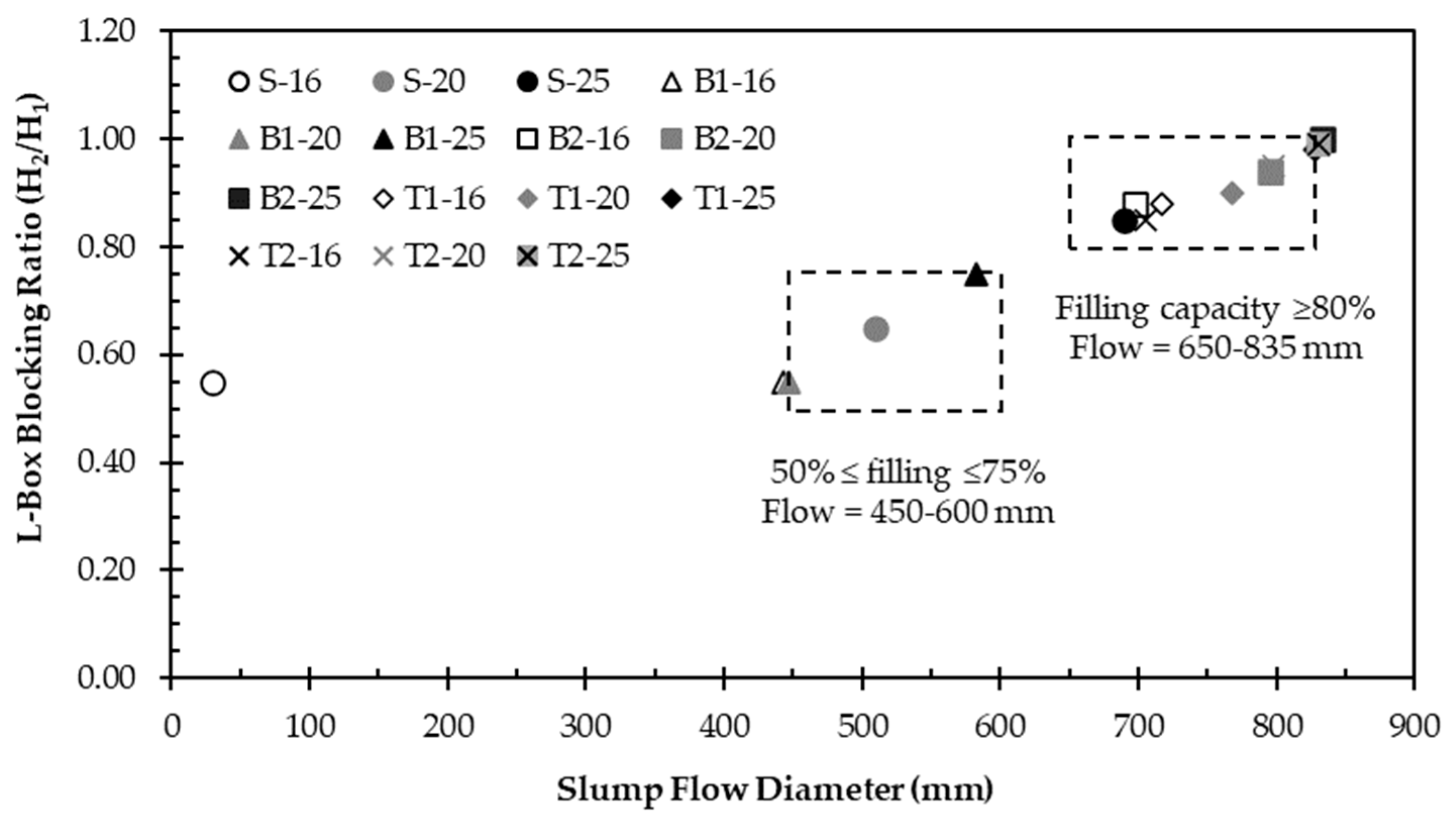
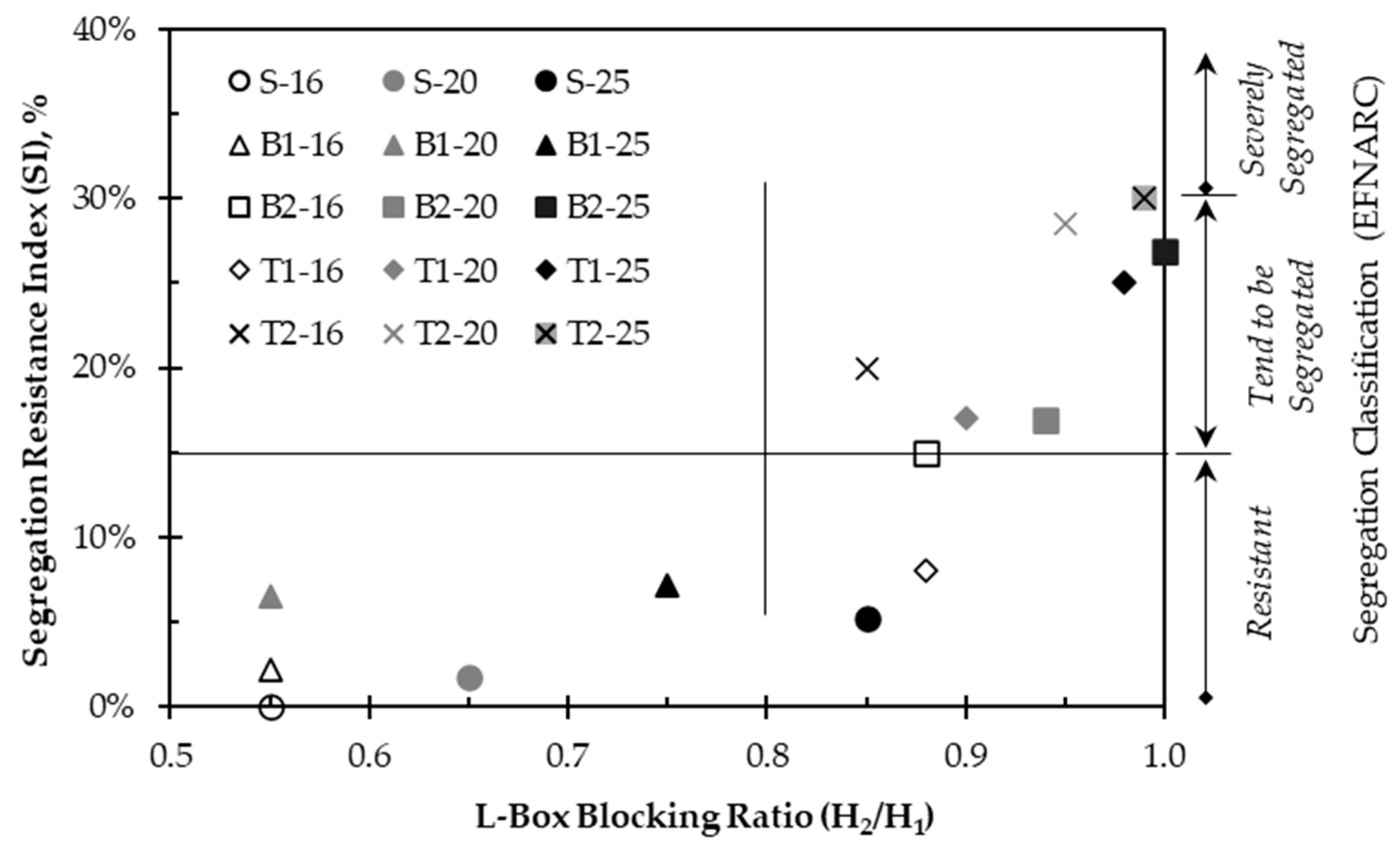
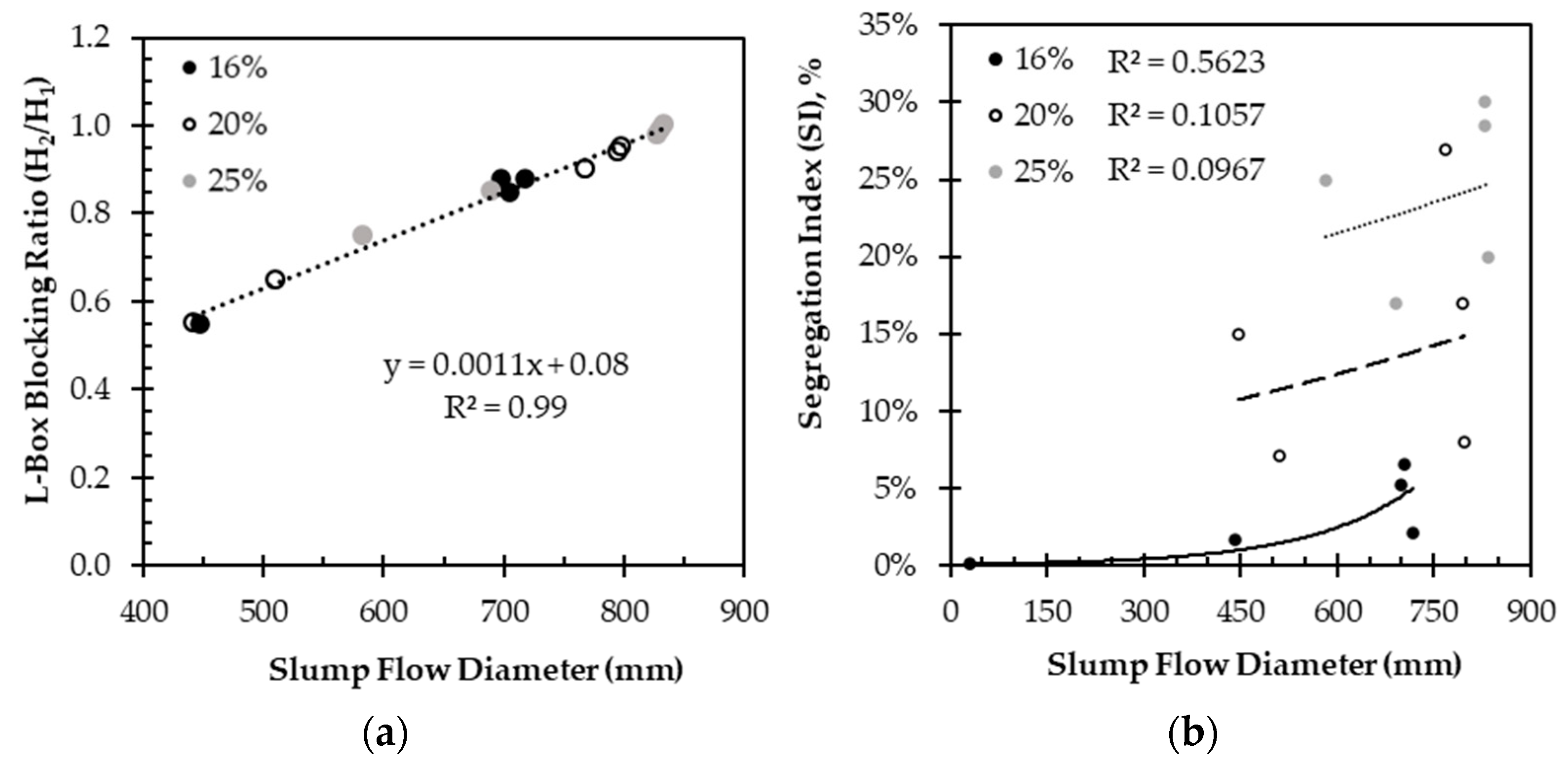

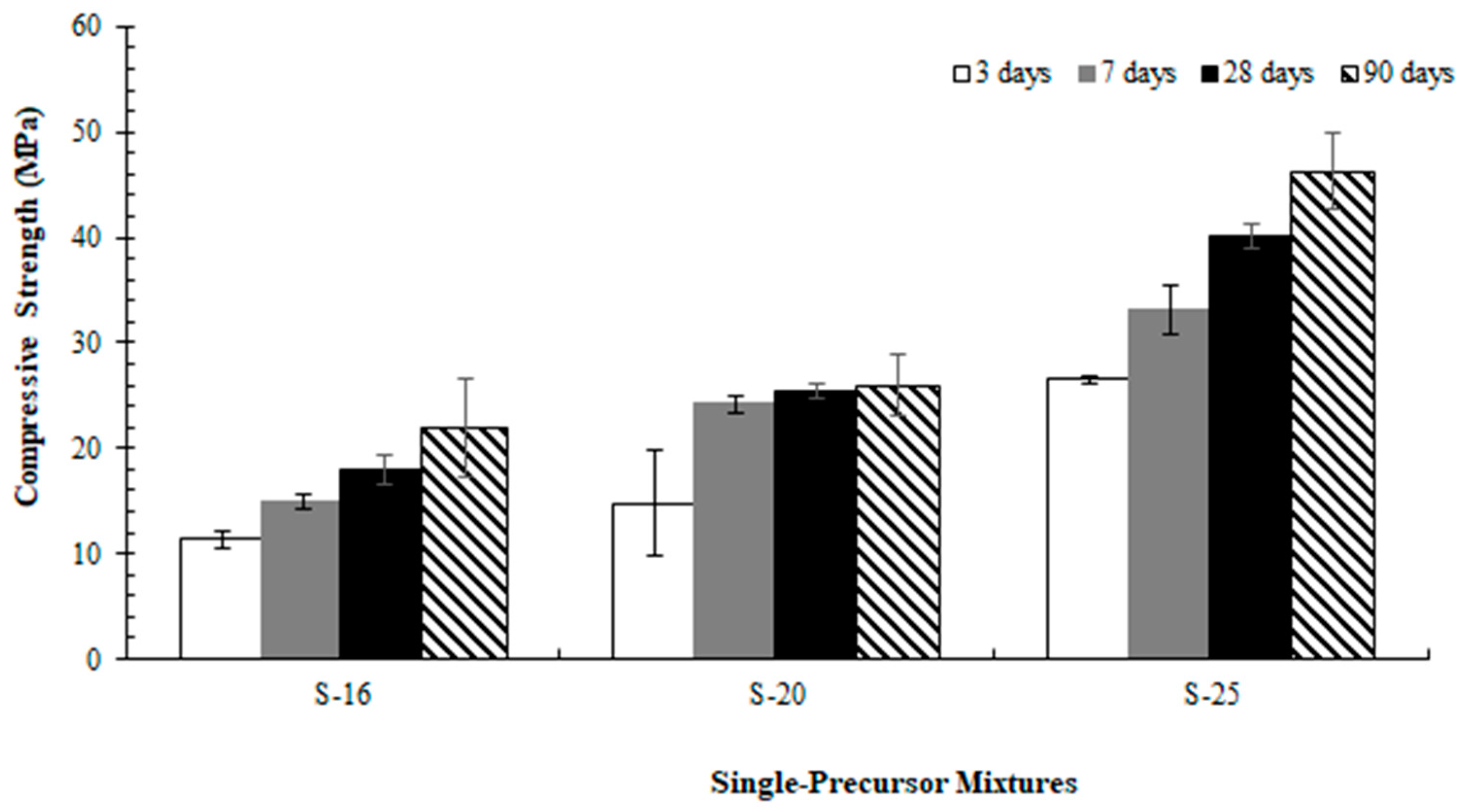


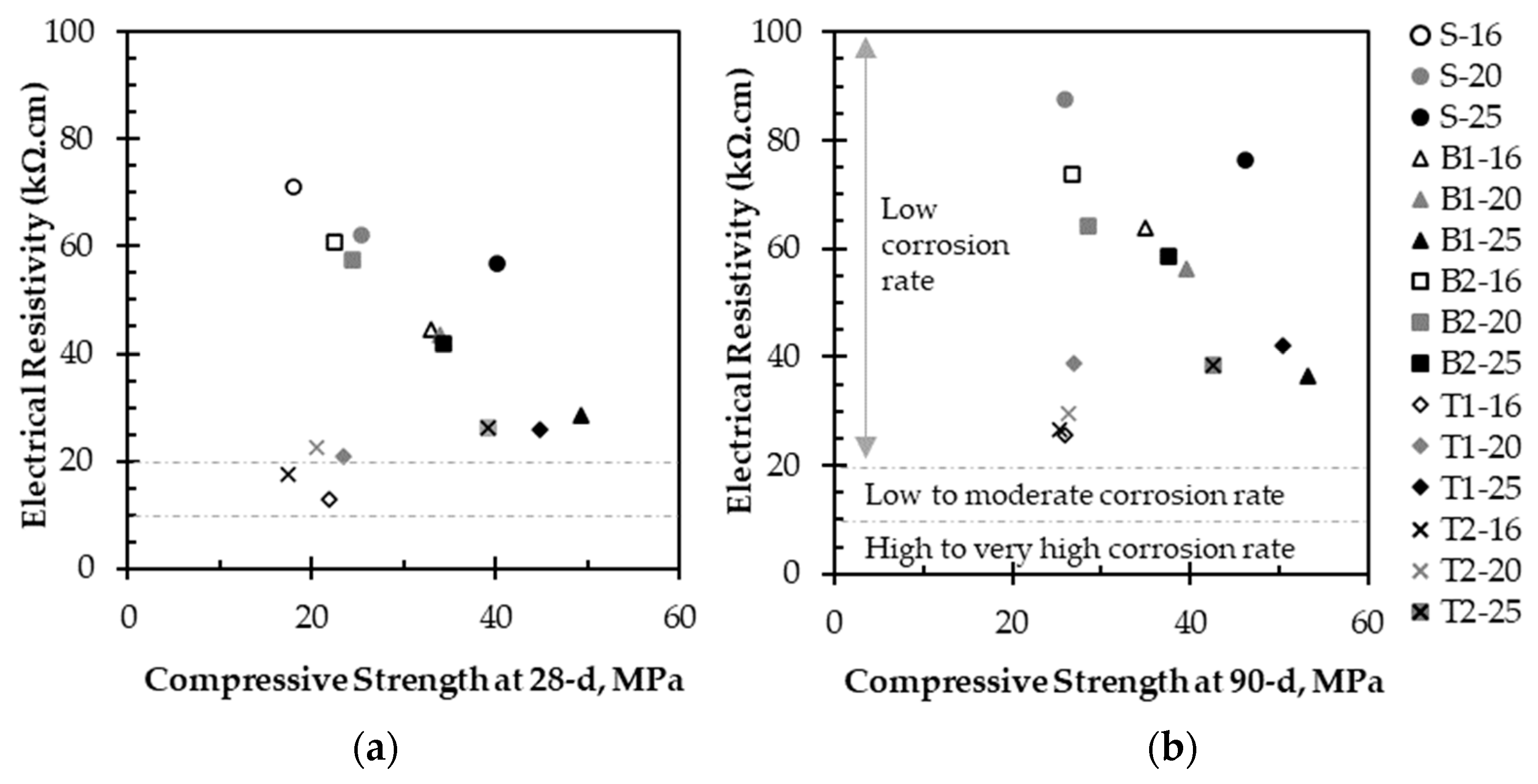

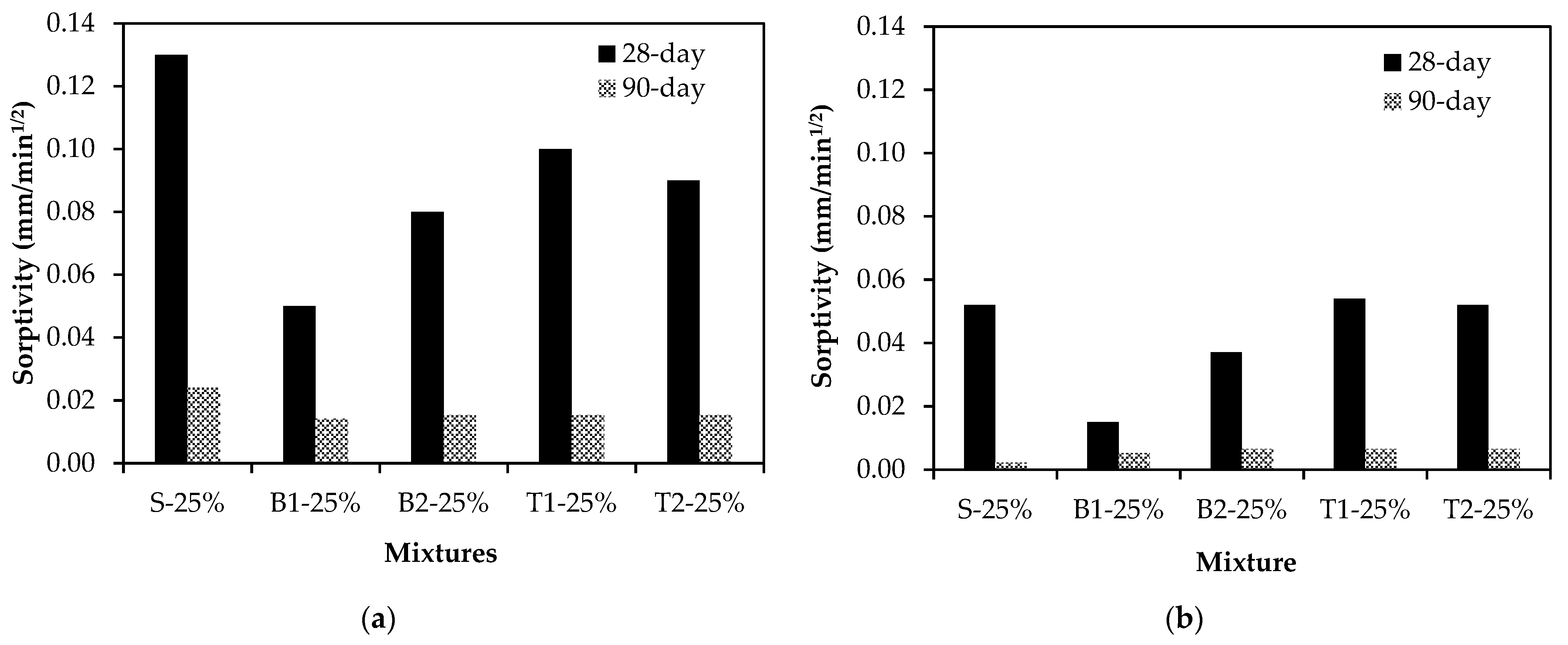
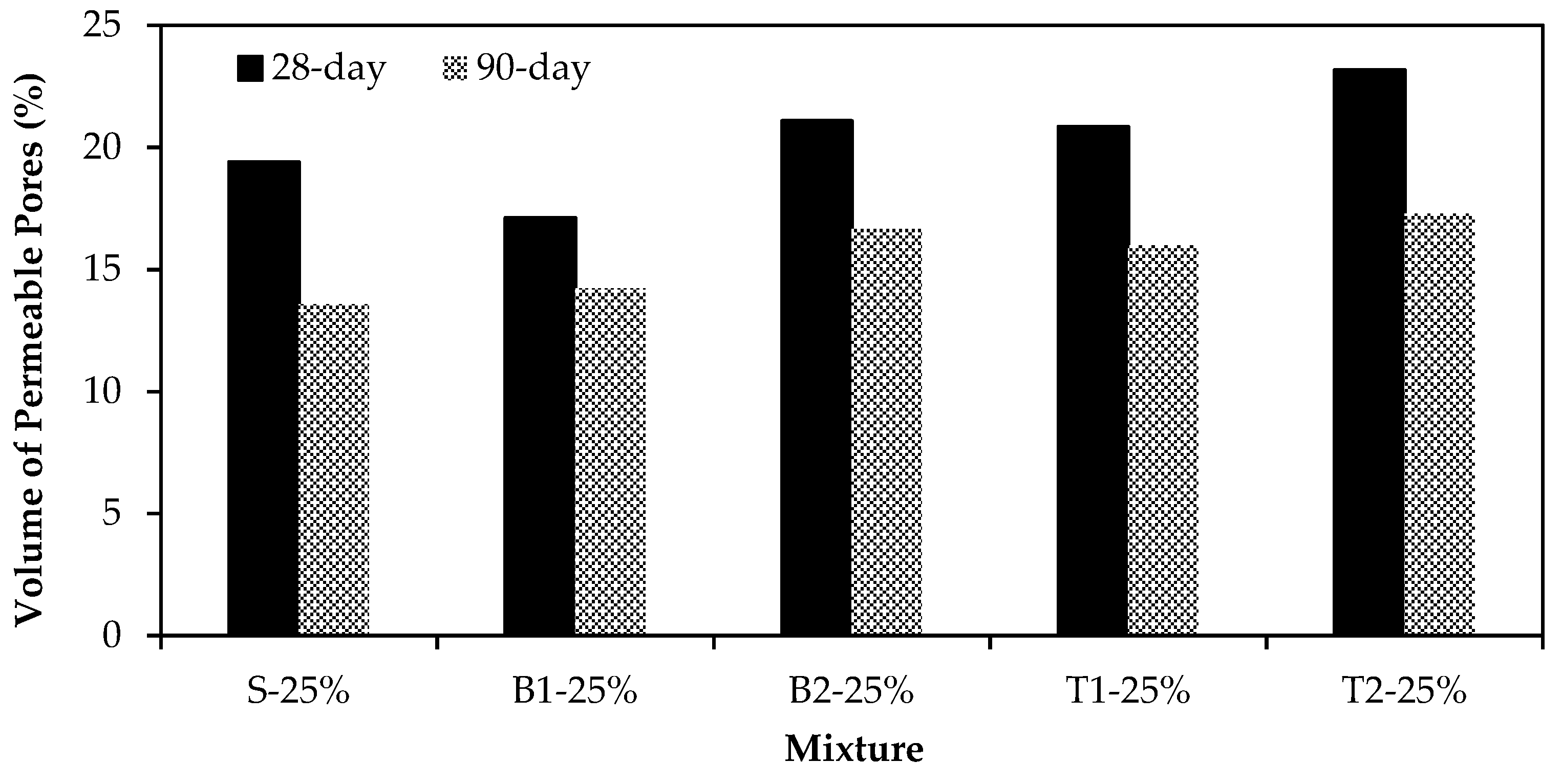
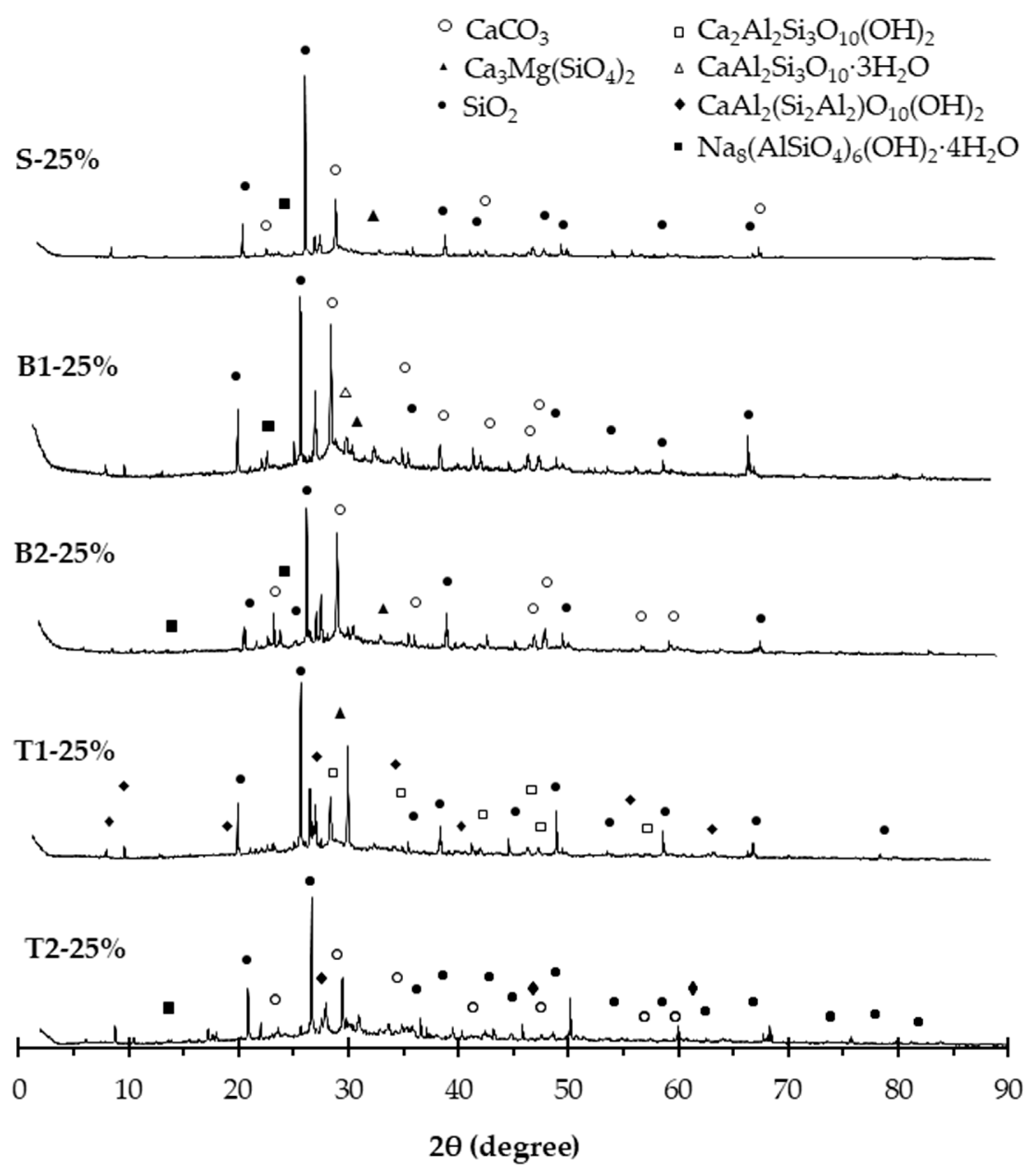
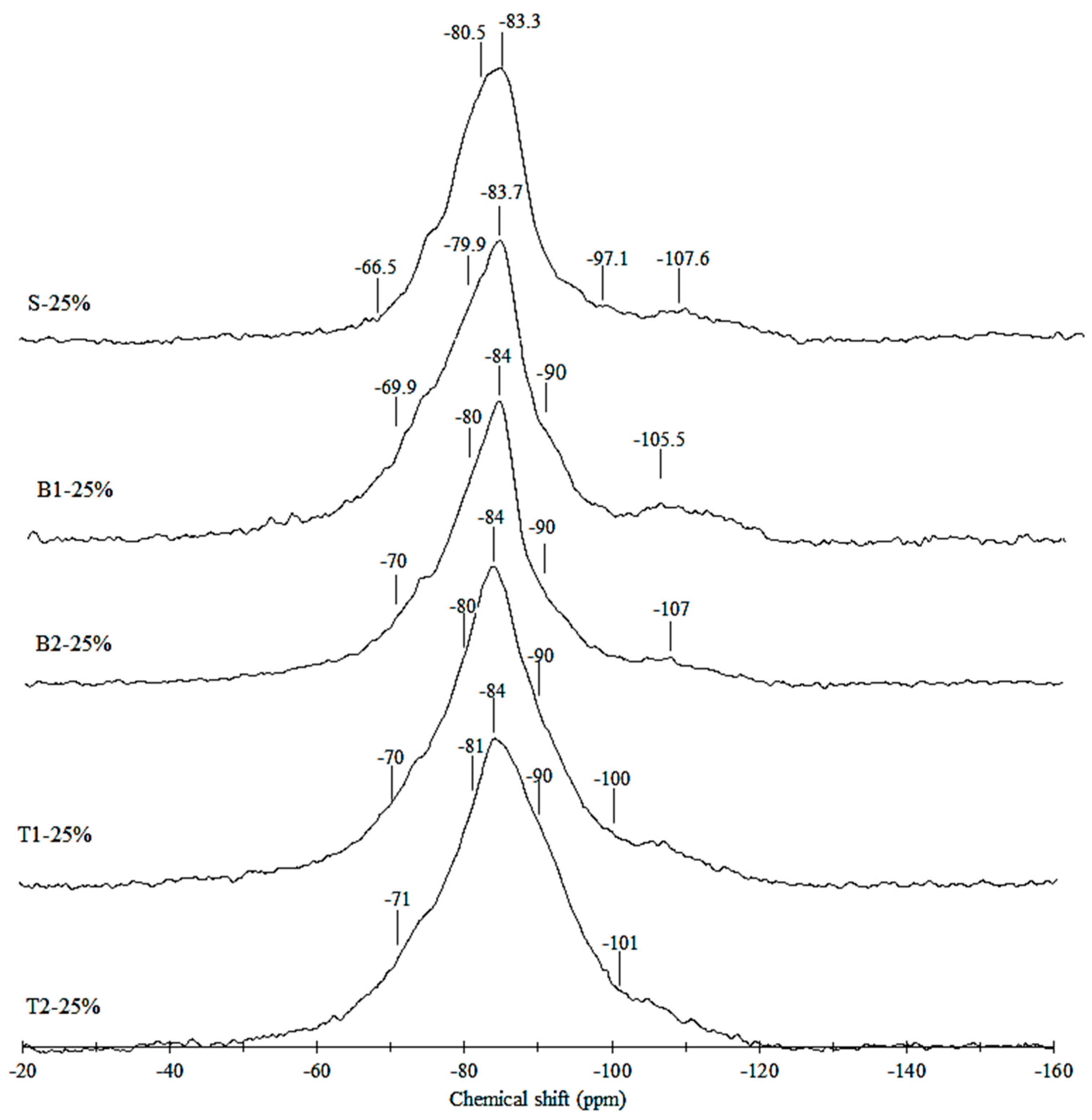
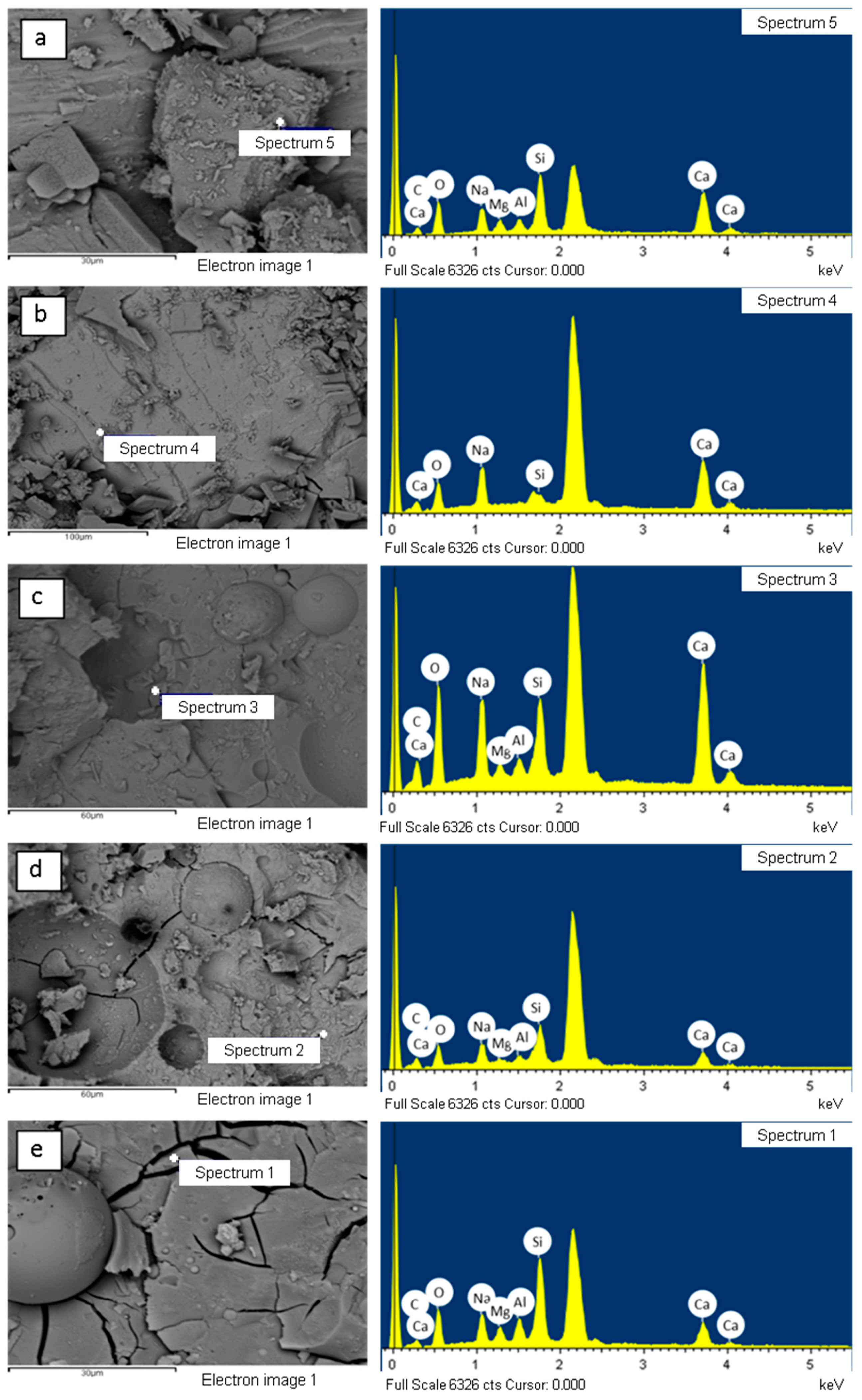
| Class | Mixture I.D. | Slag, kg/m3 | FA, kg/m3 | SF, kg/m3 | Sand, kg/m 3 | CA, kg/m3 | Paste vol., L/m3 |
|---|---|---|---|---|---|---|---|
| Single | S-16 | 525 | 0 | 0 | 661 | 830 | 438 |
| S-20 | 525 | 0 | 0 | 654 | 830 | 441 | |
| S-25 | 525 | 0 | 0 | 646 | 830 | 444 | |
| Binary-1 | B1-16 | 472.5 | 0 | 52.5 | 652 | 835 | 440 |
| B1-20 | 472.5 | 0 | 52.5 | 652 | 830 | 442 | |
| B1-25 | 472.5 | 0 | 52.5 | 652 | 825 | 443 | |
| Binary-2 | B2-16 | 367.5 | 157.5 | 0 | 641 | 845 | 440 |
| B2-20 | 367.5 | 157.5 | 0 | 637 | 845 | 442 | |
| B2-25 | 367.5 | 157.5 | 0 | 637 | 840 | 443 | |
| Ternary-1 | T1-16 | 315 | 173 | 37 | 629 | 845 | 445 |
| T1-20 | 315 | 173 | 37 | 625 | 845 | 446 | |
| T1-25 | 315 | 173 | 37 | 625 | 840 | 448 | |
| Ternary-2 | T2-16 | 289 | 210 | 26 | 629 | 845 | 445 |
| T2-20 | 289 | 210 | 26 | 625 | 845 | 446 | |
| T2-25 | 289 | 210 | 26 | 624 | 840 | 448 |
| Properties | Test Method | Specimens | Testing Periods | |
|---|---|---|---|---|
| Fresh properties | ||||
| Filling ability | Slump flow (S-flow) | ASTM C1611 [22] | - | Fresh |
| T500 | - | Fresh | ||
| Passing ability | L-box flow | EFNARC [11] | - | Fresh |
| Stability | Segregation resistance | EFNARC [11] | - | Fresh |
| Visual Stability Index | ASTM C1611 [22] | - | Fresh | |
| Hardened mechanical properties | ||||
| Unconfined compressive strength (UCS) | ASTM C39 [23] | 100 Ø 200 mm | 3, 7, 28, and 90 days | |
| Ultrasonic pulse velocity | ASTM C1760 [24] | 100 Ø 200 mm | 28 and 90 days | |
| Electrical resistivity | ||||
| Absorption | ASTM C642 [25] | 100 Ø 50 mm | - | |
| Sorptivity | ASTM C1585 [26] | 100 Ø 50 mm | - | |
| Microstructural properties | ||||
| X-ray diffraction | - | Powder < 75 µm | 90 days | |
| 29Si NMR spectra | - | Powder < 75 µm | 90 days | |
| Scanning electron microscopy | - | Small pieces | 90 days | |
| Mixture I.D. | S-flow, mm | S-flow Rate (T500), s | L-Box Ratio, H2/H1 | Segregation Index (%) |
|---|---|---|---|---|
| S-16% | 30.00 | --- | 0.55 | 0.00 |
| S-20% | 510.00 | 4.60 | 0.65 | 2.00 |
| S-25% | 690.00 | 2.02 | 0.85 | 5.00 |
| B1-16% | 443.00 | 13.60 | 0.55 | 2.00 |
| B1-20% | 448.00 | 8.82 | 0.55 | 7.00 |
| B1-25% | 583.00 | 3.05 | 0.75 | 7.00 |
| B2-16% | 698.00 | 2.44 | 0.88 | 15.00 |
| B2-20% | 795.00 | 1.41 | 0.94 | 17.00 |
| B2-25% | 833.00 | 1.13 | 1.00 | 27.00 |
| T1-16% | 718.00 | 2.66 | 0.88 | 8.00 |
| T1-20% | 768.00 | 2.10 | 0.90 | 17.00 |
| T1-25% | 828.00 | 1.45 | 0.98 | 25.00 |
| T2-16% | 705.00 | 2.63 | 0.85 | 20.00 |
| T2-20% | 798.00 | 1.84 | 0.95 | 28.00 |
| T2-25% | 830.00 | 1.10 | 0.99 | 30.00 |
| Mixture ID | Electrical Resistivity, kΩ. cm | Corrosion Protection | |
|---|---|---|---|
| 28-d | 90-d | ||
| S-16% | 71.10 | 108.56 | Very High |
| S-20% | 62.27 | 87.50 | Very High |
| S-25% | 56.70 | 76.37 | Very High |
| B1-16% | 44.61 | 63.74 | Very High |
| B1-20% | 43.48 | 56.35 | Very High |
| B1-25% | 28.53 | 36.59 | Very High |
| B2-16% | 60.84 | 73.67 | Very High |
| B2-20% | 57.40 | 64.21 | Very High |
| B2-25% | 41.75 | 58.48 | Very High |
| T1-16% | 13.00 | 25.51 | High to Very High |
| T1-20% | 21.23 | 38.69 | Very High |
| T1-25% | 26.39 | 42.16 | Very High |
| T2-16% | 17.65 | 26.64 | High to Very High |
| T2-20% | 22.67 | 29.54 | Very High |
| T2-25% | 26.35 | 38.37 | Very High |
| Mixture ID | UPV, m/s | AASCC Quality | |
|---|---|---|---|
| 28-d | 90-d | ||
| S-16% | 3225 | 3275 | Medium |
| S-20% | 3294 | 3316 | Medium |
| S-25% | 3824 | 3944 | Good |
| B1-16% | 3696 | 3796 | Good |
| B1-20% | 3710 | 3860 | Good |
| B1-25% | 4098 | 4262 | Good |
| B2-16% | 3484 | 3714 | Medium to Good |
| B2-20% | 3521 | 3721 | Good |
| B2-25% | 3883 | 4133 | Good |
| T1-16% | 3590 | 3659 | Good |
| T1-20% | 3677 | 3686 | Good |
| T1-25% | 4016 | 4041 | Good |
| T2-16% | 3446 | 3582 | Medium to Good |
| T2-20% | 3472 | 3594 | Medium to Good |
| T2-25% | 3846 | 3981 | Good |
Disclaimer/Publisher’s Note: The statements, opinions and data contained in all publications are solely those of the individual author(s) and contributor(s) and not of MDPI and/or the editor(s). MDPI and/or the editor(s) disclaim responsibility for any injury to people or property resulting from any ideas, methods, instructions or products referred to in the content. |
© 2023 by the authors. Licensee MDPI, Basel, Switzerland. This article is an open access article distributed under the terms and conditions of the Creative Commons Attribution (CC BY) license (https://creativecommons.org/licenses/by/4.0/).
Share and Cite
Kanaan, D.; Safhi, A.e.M.; Suleiman, A.R.; Soliman, A.M. Fresh, Hardened, and Microstructural Properties of Ambient Cured One-Part Alkali-Activated Self-Consolidating Concrete. Sustainability 2023, 15, 2451. https://doi.org/10.3390/su15032451
Kanaan D, Safhi AeM, Suleiman AR, Soliman AM. Fresh, Hardened, and Microstructural Properties of Ambient Cured One-Part Alkali-Activated Self-Consolidating Concrete. Sustainability. 2023; 15(3):2451. https://doi.org/10.3390/su15032451
Chicago/Turabian StyleKanaan, Dima, Amine el Mahdi Safhi, Ahmed R. Suleiman, and Ahmed M. Soliman. 2023. "Fresh, Hardened, and Microstructural Properties of Ambient Cured One-Part Alkali-Activated Self-Consolidating Concrete" Sustainability 15, no. 3: 2451. https://doi.org/10.3390/su15032451







